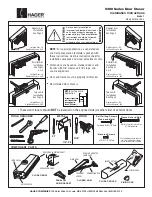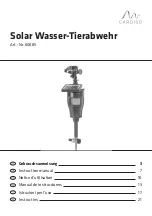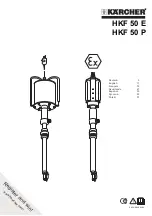
Si37-701
Test Operation
Test Operation
153
<Air tight test>
Pressurize the liquid pipe, suction gas pipe, HP/LP gas pipe and equalizer pipe from the
service ports of each shutoff valve to 4.0MPa (40bar) (do not pressurize more than 4.0MPa
(40bar)). If the pressure does not drop within 24 hours, the system passes the test.
If there is a pressure drop, check for leaks, make repairs and perform the airtight test again.
<Vacuum drying>
Evacuate the system from the liquid and gas pipes by using a vacuum pump for more than 2
hours and bring the system to –100.7kPa or less. After keeping the system under that condition
for more than 1 hour, check if the vacuum gauge rises or not. If it rises, the system may either
contain moisture inside or have leaks.
Note:
If moisture might enter the piping, follow below.
(I.e., if doing work during the rainy season, if the actual work takes long enough that
condensation may form on the inside of the pipes, if rain might enter the pipes during
work, etc.)
1. After performing the vacuum drying for two hours, pressurize to 0.05 MPa (i.e., vacuum
breakdown) with nitrogen gas, then depressurize down to –100.7 kPa for an hour using the
vacuum pump (vacuum drying).
2. If the pressure does not reach –100.7 kPa even after depressurizing for at least two hours,
repeat the vacuum breakdown - vacuum drying process.
After vacuum drying, maintain the vacuum for an hour and make sure the pressure does not rise
by monitoring with a vacuum gauge.
1.2.4 Pipe Insulation
Insulation of pipes should be done after performing
“1.2.3. Air Tight Test and Vacuum
Drying”
.
Always insulate the liquid piping, the HP/LP gas piping, the gas piping, the equalizer pipe
(between the outdoor units for the outdoor multi system) and these pipe connections.
Failing to insulate the pipes may cause leaking or burns.
Especially, be sure to insulate the HP/LP gas piping as withstanding as the suction pipe
because the suction gas follows in the HP/LP gas piping when the system is whole cooling
mode.
And be sure to use the insulation which can withstand such temperatures of 120°C or more
for the HP/LP gas piping, the equalizer pipe and the gas piping because the HP/LP gas
follows in these pipings.
Reinforce the insulation on the refrigerant piping according to the installation environment.
Condensation might form on the surface of the insulation. Refer to the below.
•
Ambient temperature : 30°C, humidity : 75% to 80% RH : min. thickness : 15mm.
•
If the ambient temperature exceeds 30°C and the humidity 80% RH, then the min.
thickness is 20mm.
See the Engineering data book for detail.
If there is a possibility that condensation on the shutoff valve might drip down into the indoor
unit through gaps in the insulation and piping because the outdoor unit is located higher than
the indoor unit, etc., this must be prevented by caulking the connections, etc.
(Refer to next
figure)
The piping lead-out hole lid should be attached after opening a knock hole.
(Refer to next
figure)
If small animals and the like might enter the unit through the piping lead-out hole, close the
hole with blocking material (procured on site) after completion of
“1.2.5 Additional
Refrigerant Charge and Check Operation”. (Refer to next figure)
Summary of Contents for VRV III REYQ8PY1
Page 1: ...REYQ8 48PY1 R 410A Heat Recovery 50Hz Si37 701...
Page 59: ...Specifications Si37 701 48 Specifications...
Page 105: ...Refrigerant Flow for Each Operation Mode Si37 701 94 Refrigerant Circuit...
Page 230: ...Si37 701 Troubleshooting by Remote Controller Troubleshooting 219...
Page 374: ...Si37 701 Piping Diagrams Appendix 363 REYQ14P 16PY1 3D058153A S2NPL S1NPH...
Page 375: ...Piping Diagrams Si37 701 364 Appendix REMQ8PY1 3D057743...
Page 376: ...Si37 701 Piping Diagrams Appendix 365 REMQ10PY1 12PY1 3D057742...
Page 377: ...Piping Diagrams Si37 701 366 Appendix REMQ14PY1 16PY1 3D057741...
Page 382: ...Si37 701 Piping Diagrams Appendix 371 1 3 BS Unit 4D057985A...
Page 384: ...Si37 701 Wiring Diagrams for Reference Appendix 373 REYQ14 16PY1 3D056774C...
Page 385: ...Wiring Diagrams for Reference Si37 701 374 Appendix REMQ8PY1 3D055307E...
Page 386: ...Si37 701 Wiring Diagrams for Reference Appendix 375 REMQ10 12PY1 3D055308E...
Page 387: ...Wiring Diagrams for Reference Si37 701 376 Appendix REMQ14P 16PY1 3D055309E...
Page 392: ...Si37 701 Wiring Diagrams for Reference Appendix 381 FXCQ40M 50M 80M 125MVE 3D039557A...
Page 394: ...Si37 701 Wiring Diagrams for Reference Appendix 383 FXZQ20M 25M 32M 40M 50M8V1B 3D038359...
Page 395: ...Wiring Diagrams for Reference Si37 701 384 Appendix FXKQ25MA 32MA 40MA 63MAVE 3D039564C...
Page 399: ...Wiring Diagrams for Reference Si37 701 388 Appendix FXDYQ180M 200M 250MV1...
Page 402: ...Si37 701 Wiring Diagrams for Reference Appendix 391 FXMQ200MA 250MAVE 3D039621B...
Page 403: ...Wiring Diagrams for Reference Si37 701 392 Appendix FXHQ32MA 63MA 100MAVE 3D039801D...
Page 406: ...Si37 701 Wiring Diagrams for Reference Appendix 395 2 4 BS Unit 3D055928C...
Page 423: ...Piping Installation Point Si37 701 412 Appendix...
Page 427: ...Example of Connection R 410A Type Si37 701 416 Appendix...
Page 433: ...Method of Checking the Inverter s Power Transistors and Diode Modules Si37 701 422 Appendix...
Page 447: ...Si37 701 iv Index...
Page 451: ...Si37 701 viii Drawings Flow Charts...
















































